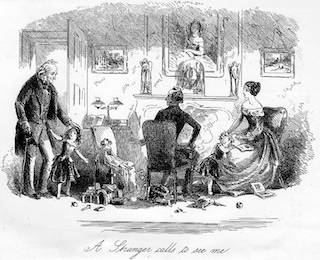Summary | Excerpt | Reading Guide | Reviews | Beyond the Book | Read-Alikes | Genres & Themes | Author Bio

A Novel
by Barbara KingsolverThis article relates to Demon Copperhead
 Barbara Kingsolver’s novel Demon Copperhead is largely based on Charles Dickens' novel David Copperfield.
Barbara Kingsolver’s novel Demon Copperhead is largely based on Charles Dickens' novel David Copperfield.
Charles Dickens (1812–1870) wrote 15 novels during his career, the eighth of which he ponderously dubbed The Personal History, Adventures, Experience and Observation of David Copperfield the Younger of Blunderstone Rookery (Which He Never Meant to Publish on Any Account). Known familiarly as David Copperfield, the novel actually began with Dickens’ attempts, between 1845 and 1848, to write an autobiography. His friend and biographer, John Forster, recalled that Dickens ultimately abandoned the nonfiction account because writing it was simply too painful. Dickens, in fact, kept the story of his impoverished youth so private that most didn’t realize David Copperfield was autobiographical until Forster’s Life of Charles Dickens was published in 1872. Regardless of the emotional toll it took, Dickens considered it his “favourite child,” and it’s the first of his major novels written entirely in the first person.
The story is narrated by Copperfield as a successful adult, looking back at his life from birth to the current day. The novel's plot divides broadly into two sections. The first concentrates on the privations of the main character’s childhood as his single mother marries a brutal man. Her death soon follows, leaving young David an orphan at his stepfather’s mercy. He is shipped off to a harsh boarding school before being forced to work at a warehouse, enduring hardship at all stages of his journey. He ultimately escapes to an eccentric aunt, who sets his feet on a more stable path.
The book’s second part follows David’s professional growth from legal clerk to reporter to, finally, successful author. More important to the plot, however, is the protagonist’s relationships with his contemporaries, particularly with his first love and, later, with a friend whom he idolizes. As the tale concludes, evil is punished and virtue rewarded, resulting in what some would call a fairytale ending. (It's interesting to note that this is Dickens' last book with a conventionally happy ending.)
Like most of Dickens’ major novels, David Copperfield was serialized, with an episode published monthly from May 1849 to November 1850. Each consisted of 32 pages of text, two illustrations by well-known artist Hablot Knight Browne (aka Phiz), and advertisements, and cost one shilling each (about £6.4/$7.35 in today’s money). At the time it didn’t sell as well as some of Dickens' earlier serializations, such as The Pickwick Papers, and critical response was mixed. It has since, however, come to be regarded as a literary masterpiece, ranking #15 on The Guardian's list of 100 best novels.
Many adaptations of David Copperfield have come to both the big and small screens over the decades. Some of the more notable include a 1935 MGM film starring Frank Lawton as the adult Copperfield alongside such film greats as Lionel Barrymore, Elsa Lancaster, Basil Rathbone and W.C. Fields, and a well-regarded 1999 BBC production starring Daniel Radcliffe as the young Copperfield and featuring Maggie Smith and Ian McKellen in supporting roles.
"A Stranger calls to see me," by Phiz (Hablot K. Browne) from David Copperfield, 1850. Picture from Victorianweb.org
Filed under Books and Authors
![]() This "beyond the book article" relates to Demon Copperhead. It originally ran in November 2022 and has been updated for the
August 2024 paperback edition.
Go to magazine.
This "beyond the book article" relates to Demon Copperhead. It originally ran in November 2022 and has been updated for the
August 2024 paperback edition.
Go to magazine.
When men are not regretting that life is so short, they are doing something to kill time.
Click Here to find out who said this, as well as discovering other famous literary quotes!
Your guide toexceptional books
BookBrowse seeks out and recommends the best in contemporary fiction and nonfiction—books that not only engage and entertain but also deepen our understanding of ourselves and the world around us.